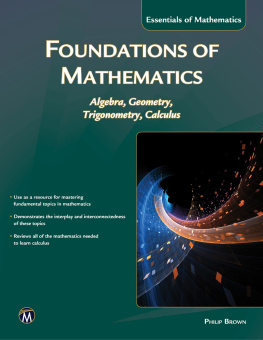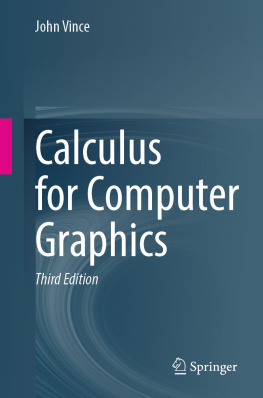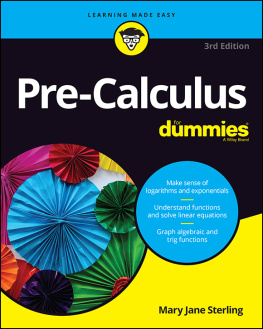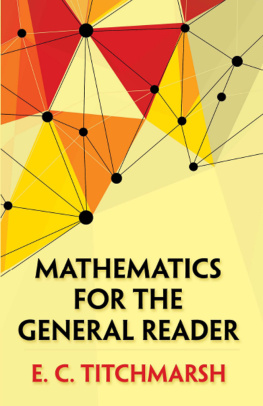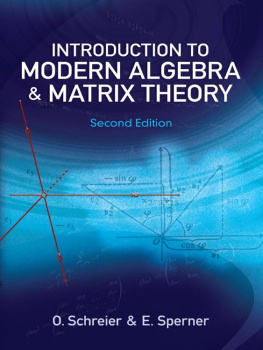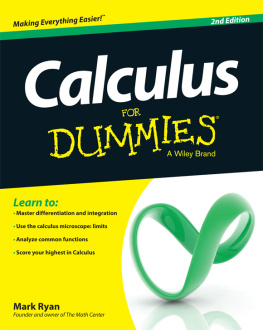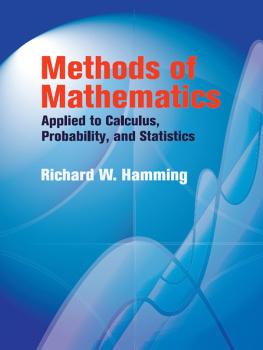Contents
Pagebreaks of the print version
FOUNDATIONS
OF
MATHEMATICS
LICENSE, DISCLAIMER OF LIABILITY, AND LIMITED WARRANTY
By purchasing or using this book (the Work), you agree that this license grants permission to use the contents contained herein, but does not give you the right of ownership to any of the textual content in the book or ownership to any of the information or products contained in it. This license does not permit uploading of the Work onto the Internet or on a network (of any kind) without the written consent of the Publisher. Duplication or dissemination of any text, code, simulations, images, etc. contained herein is limited to and subject to licensing terms for the respective products, and permission must be obtained from the Publisher or the owner of the content, etc., in order to reproduce or network any portion of the textual material (in any media) that is contained in the Work.
MERCURY LEARNING AND INFORMATION (MLI or the Publisher) and anyone involved in the creation, writing, or production of the companion disc, accompanying algorithms, code, or computer programs (the software), and any accompanying Web site or software of the Work, cannot and do not warrant the performance or results that might be obtained by using the contents of the Work. The author, developers, and the Publisher have used their best efforts to insure the accuracy and functionality of the textual material and/or programs contained in this package; we, however, make no warranty of any kind, express or implied, regarding the performance of these contents or programs. The Work is sold as is without warranty (except for defective materials used in manufacturing the book or due to faulty workmanship).
The author, developers, and the publisher of any accompanying content, and anyone involved in the composition, production, and manufacturing of this work will not be liable for damages of any kind arising out of the use of (or the inability to use) the algorithms, source code, computer programs, or textual material contained in this publication. This includes, but is not limited to, loss of revenue or profit, or other incidental, physical, or consequential damages arising out of the use of this Work.
The sole remedy in the event of a claim of any kind is expressly limited to replacement of the book, and only at the discretion of the Publisher. The use of implied warranty and certain exclusions vary from state to state, and might not apply to the purchaser of this product.
FOUNDATIONS
OF
MATHEMATICS
Algebra, Geometry, Trigonometry, Calculus
Philip Brown
Texas A&M University at Galveston

Copyright 2016 by MERCURY LEARNING AND INFORMATION LLC. All rights reserved.
This publication, portions of it, or any accompanying software may not be reproduced in any way, stored in a retrieval system of any type, or transmitted by any means, media, electronic display or mechanical display, including, but not limited to, photocopy, recording, Internet postings, or scanning, without prior permission in writing from the publisher.
Publisher: David Pallai
MERCURY LEARNING AND INFORMATION
22841 QUICKSILVER DRIVE
Dulles, VA 20166
www.merclearning.com
(800) 232-0223
Philip Brown. Foundations of Mathematics: Algebra, Geometry, Trigonometry, Calculus
ISBN: 978-1-942270-75-1
The publisher recognizes and respects all marks used by companies, manufacturers, and developers as a means to distinguish their products. All brand names and product names mentioned in this book are trademarks or service marks of their respective companies. Any omission or misuse (of any kind) of service marks or trademarks, etc. is not an attempt to infringe on the property of others.
Library of Congress Control Number: 2015957711
161718321 This book is printed on acid-free paper.
Our titles are available for adoption, license, or bulk purchase by institutions, corporations, etc.
For additional information, please contact the Customer Service Dept. at 800-232-0223(toll free).
All of our titles are available in digital format at . The sole obligation of MERCURY LEARNING AND INFORMATION to the purchaser is to replace the book, based on defective materials or faulty workmanship, but not based on the operation or functionality of the product.
CONTENTS
PREFACE
This book is intended primarily for university students. In particular, this book can be used as a textbook or an additional reference book by university students attending a course in algebra, trigonometry, geometry, or calculus. As a calculus textbook, this book is unique in that it contains all the mathematics (and more) that students will need to know in order to be successful in a calculus course. For this reason, the book will be invaluable for students who may need to fill in some gaps in their mathematical background, or review certain topics, while attending a university level calculus course. (Calculus professors will normally not have the time to do this!)
Mathematics can be appreciated and enjoyed more when it is presented as a development of ideas. Hence, there is a strong emphasis in this book on the unfolding and development of the concepts, and there are comments throughout the book to help the reader trace the historical development of mathematics. Of course, students also need to develop their skills. For this reason, there are many exercises included at the ends of the chapters, and students are encouraged to do all of them as an essential part of working through the book. The range of topics in this book, and examples that demonstrate their interplay and interconnectedness is another unique aspect of the book. This is a rewarding aspect of learning mathematics, which university students are typically not exposed to because of the way current-day university courses are organized.
The four chapters that make up the introduction to algebra are presents many of the theorems that are important in Euclidean Geometry, along with some guides to solving problems in geometry.
Because many students have difficulties with algebra when they enroll in a university calculus course, a first semester course in calculus may well consist of includes an introduction to partial fractions, a topic that is usually not taught to students until they reach their second semester of calculus.
In the following two paragraphs, some comments are made regarding the presentation of the material in .
It is usual, in most calculus textbooks, for the rules for limits to be taken as the starting point for the evaluation of limits. In , the slightly different approach to evaluating limits is to take as a fact the continuity of all of the standard functions and any algebraic combinations and compositions of the standard functions. (This fact can be proved using methods of real analysis, which is too advanced for this book.) This means that a limit to any point in the domain of any of these functions can be evaluated simply by making a substitution into the function (i.e., by an application of the equation of continuity). The rules for limits are introduced, instead, at the end of the chapter, where they are used to evaluate certain limits involving trigonometric functions.
In , the derivative of a function is first defined in the special case that the graph of the function passes through the origin, and the tangent line (through the origin) is defined in a precise way as the

